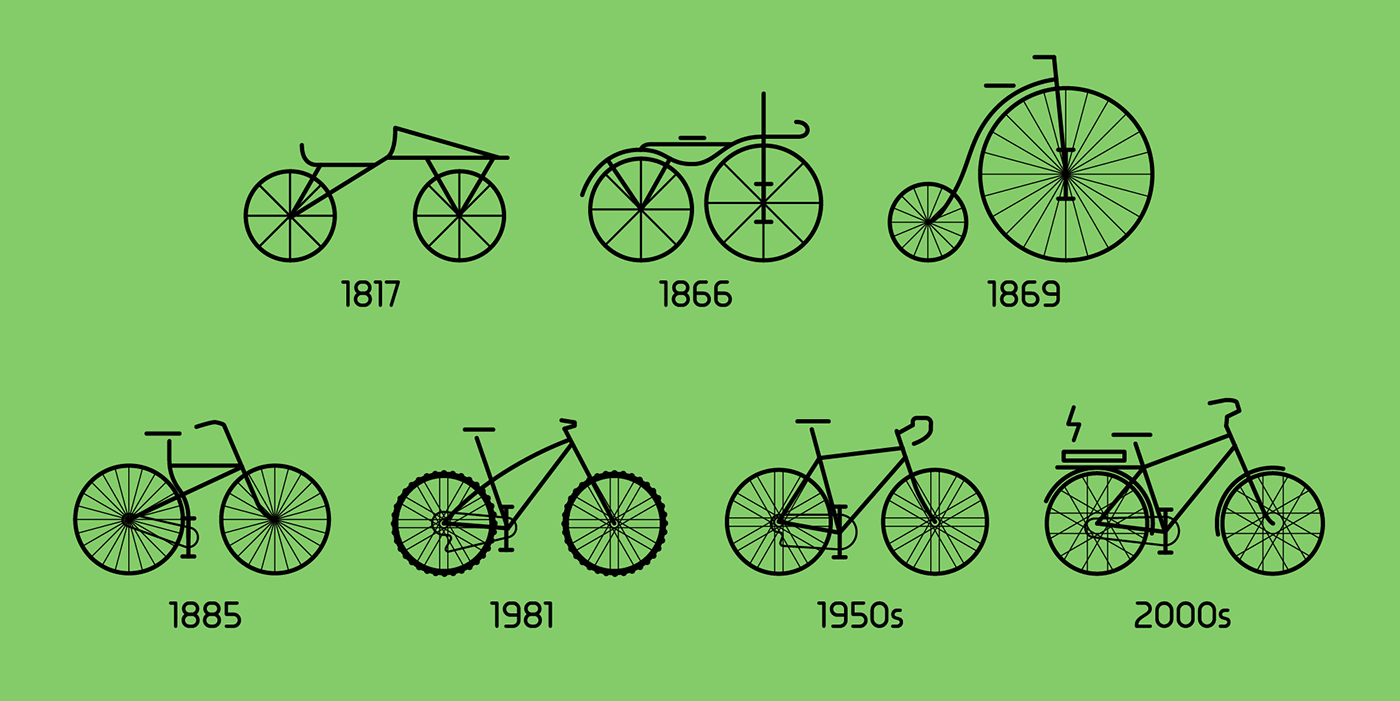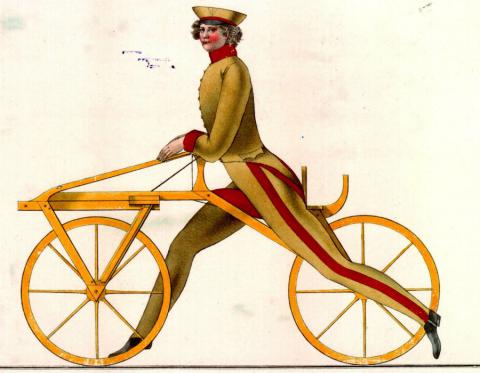Imagine gliding down a peaceful path, the wind in your hair and the world at your feet. This sense of freedom and adventure is what bicycles offer.
But have you ever wondered how this simple yet transformative invention came to be? The history of the bicycle is a fascinating tale of innovation and cultural shifts that have shaped the way you move and explore your surroundings. As you delve into this story, you’ll uncover surprising details about how bicycles evolved, impacting everything from transportation to leisure.
Get ready to pedal through time and discover the intriguing journey that has led to the bicycles you know and love today.
Origins of The Bicycle

Credit: www.behance.net
Bicycles began as wooden prototypes in the 19th century. Early designs evolved into pedal-powered models, gaining popularity for transportation. These inventions paved the way for modern bicycles, enhancing mobility and leisure.
The bicycle, a seemingly simple invention, has significantly impacted daily life and transportation. Understanding its origins gives us insight into human creativity and the quest for efficient movement. The story begins with early attempts to create a machine that could harness human power.
Early Inventions
In the early 19th century, inventors started experimenting with human-powered vehicles. These early inventions were rudimentary and lacked pedals. One notable example is the “celerifere,” a wooden contraption with two wheels that users pushed along with their feet.
These early machines were more novelties than practical transportation. Yet, they laid the groundwork for the innovative designs that followed. They sparked the imagination of inventors who dreamed of better ways to move.
The Draisine
The first step towards a modern bicycle came with the Draisine, invented by Karl Drais in 1817. This two-wheeled vehicle, also known as the “running machine,” was steered with handlebars and propelled by pushing off the ground with your feet.
Imagine gliding along a park path on a Draisine, feeling the thrill of speed without a horse. It was a breakthrough, offering a new way to travel short distances. Though limited, it inspired further innovation in personal transportation.
Velocipede Era
The Velocipede, often called the “boneshaker,” emerged in the 1860s. With pedals attached to the front wheel, it was the first pedaled bicycle. Its iron and wood construction made for a bumpy ride, hence the nickname.
Riding a velocipede required balance and stamina, but it marked a significant advance. It was the first time people could move efficiently with minimal effort. This era set the stage for the development of the safety bicycle, which would revolutionize transportation.
As you read about these early inventions, consider how they reflect the spirit of innovation. What drives people to improve upon what already exists? The story of the bicycle’s origins is a testament to human ingenuity and the desire to make life a little smoother, one pedal at a time.
The Birth of The Modern Bicycle

Credit: bicyclenetwork.com.au
The birth of the modern bicycle changed how people travel. It made cycling safer and more accessible for everyone. The shift from earlier designs to the modern bicycle marked a pivotal moment. This evolution ushered in a new era of personal transportation.
Invention Of The Safety Bicycle
The safety bicycle was a major step forward. Its design was simple yet effective. Before its invention, bicycles were often dangerous. Riders struggled with balance and control. The safety bicycle introduced two equal-sized wheels. This provided stability and ease of use.
Another key feature was the chain drive. It transferred power from the pedals to the rear wheel. This mechanism allowed smoother and more efficient riding. The safety bicycle became very popular quickly. It set the standard for future bicycle designs.
The Role Of John Kemp Starley
John Kemp Starley played a crucial role in bicycle history. He was an inventor with a vision for safer bicycles. Starley designed the Rover Safety Bicycle in 1885. His creation featured innovations that improved safety and comfort.
Starley’s design included a diamond-shaped frame. This provided strength and durability. The Rover Safety Bicycle became the model for modern bicycles. Starley’s work influenced bicycle design for generations. His contributions are still felt today.
Technological Advancements

Credit: www.ebikekit.com
The bicycle’s evolution is marked by incredible technological advancements. These innovations transformed the way we ride. From simple designs to complex machinery, each improvement made cycling easier and more enjoyable. Let’s explore some key advancements that shaped modern bicycles.
Development Of Gears
Gears changed the cycling experience. Early bicycles had fixed gears. This meant riders struggled on hills. With gear systems, cyclists could adjust their effort. Multiple gears allowed smooth transitions between different terrains. Riders gained speed and control. Gear development was a leap forward in cycling technology.
Improved Braking Systems
Braking systems evolved significantly over time. Early brakes were basic and unreliable. Modern brakes offer precision and safety. Disc brakes provide consistent stopping power. Even in wet conditions, they perform well. Improved braking systems give cyclists confidence. They can now ride faster and stop quickly.
Lightweight Materials
The introduction of lightweight materials transformed bicycle design. Early bicycles were heavy and cumbersome. Aluminum and carbon fiber became popular choices. These materials reduced weight drastically. Cyclists could now ride longer distances with less effort. Lightweight frames also enhanced speed and agility. These materials reshaped the cycling industry.
Cultural Impact of Bicycle
The bicycle has woven its way into the fabric of society. Its cultural impact reaches far beyond mere transportation. Bicycles have shaped cities, influenced social norms, and inspired art. They are more than two wheels and a frame. They are a symbol of change and creativity.
Bicycles And Urban Mobility
Cities have embraced bicycles to improve urban mobility. They offer an eco-friendly way to navigate crowded streets. With less pollution, they help create cleaner urban environments. Bicycles also reduce traffic congestion. They take up less space than cars. Many cities have developed bike lanes and rental services. This encourages more people to cycle. Bicycles make cities more livable and accessible.
Cycling And Social Change
Bicycles have played a role in social change. They offered freedom and independence, especially for women. In the late 19th century, women rode bicycles to challenge social norms. It allowed them to travel alone, breaking free from societal constraints. Bicycles also became tools of protest. They have been used in various movements around the world. Cycling promotes equality and empowerment.
Bicycles In The Arts
Bicycles inspire artists and writers. They appear in paintings, films, and literature. Artists capture the grace and simplicity of bicycles. Films often use bicycles to symbolize freedom or escape. Bicycles in literature tell stories of adventure and discovery. They are a muse for many creative minds. Their presence in art reflects their cultural significance.
Bicycles In Sports
Bicycles have a rich history in sports, dating back to the 19th century. Early cycling races showcased human endurance and innovation. Over time, bicycles evolved, influencing modern competitive sports.
Bicycles have always been more than just a means of transportation. Their role in sports has evolved dramatically over the years. From thrilling races to challenging terrains, bicycles in sports offer adrenaline, competition, and an unbeatable sense of achievement.
Whether you’re a cycling enthusiast or just curious, understanding the history of bicycles in sports can add a whole new dimension to your appreciation of these two-wheeled wonders.
Introduction To Competitive Cycling
Competitive cycling is an exhilarating world. It’s where speed meets strategy. You can almost feel the rush of wind as cyclists race towards the finish line. Have you ever wondered why cycling races are so captivating? It’s the thrill of competition coupled with the challenge of endurance.
From local races to world championships, competitive cycling has grown in popularity. Riders train for years, honing their skills and pushing their limits. The sport is not just about speed; it’s about tactics and teamwork.
Famous Cycling Races
Cycling races are iconic events. Imagine the excitement of the Tour de France, where cyclists navigate through diverse terrains across France. This race is not just about winning; it’s a test of resilience and strategy.
There’s also the Giro d’Italia, which showcases Italy’s stunning landscapes. Each race has its unique challenges, from mountainous climbs to rapid descents. Have you ever watched these races and thought about the dedication required to compete?
These races draw spectators from around the world, each event highlighting the cultural and geographical diversity of the host country.
The Rise of Mountain Biking
Mountain biking is where adventure meets skill. Unlike traditional cycling races, mountain biking challenges you with unpredictable terrains. Imagine the adrenaline rush as you navigate rocky trails and steep descents.
Mountain biking has seen a surge in popularity. It appeals to those who crave adventure and love nature. The sport encourages you to push boundaries and explore off-the-beaten-path trails.
As mountain biking grows, more competitions are being held globally. These events test endurance, technical skills, and bravery. Have you ever thought of trying mountain biking and experiencing the thrill first-hand?
Cycling in sports is an ever-evolving world, offering challenges and excitement at every turn. Whether it’s the precision of competitive cycling, the prestige of famous races, or the adventure of mountain biking, the bicycle has cemented its place in sports history. What’s your next cycling adventure?
Bicycles And Environmental Movement
The humble bicycle has long been a symbol of freedom and adventure. Yet, in recent decades, it has become a powerful tool for environmental change. As cities grapple with pollution and congestion, bicycles offer a green solution. They are not just a mode of transport; they are a movement. Let’s explore how bicycles are reshaping our world.
Green Transportation
Have you ever thought about your carbon footprint when driving to work? Switching to cycling can dramatically reduce it. Bicycles produce zero emissions. Each pedal stroke is a step towards cleaner air and quieter streets.
It’s not just about reducing pollution. Cycling also cuts down on energy consumption. No fuel, no electricity—just you and the road. Imagine a city where bicycles outnumber cars. Wouldn’t it be wonderful to breathe easier and hear birds instead of engines?
Cycling Advocacy
Advocates are pushing for more bike-friendly cities. They lobby for dedicated bike lanes and safer cycling paths. The aim is to make cycling an everyday option for everyone. Advocacy groups also educate the public about the benefits of cycling.
Have you ever joined a cycling rally? It’s an exhilarating way to show support and demand change. Your participation can help shift policies and priorities. By championing cycling, you contribute to a cleaner, greener world.
Global Bicycle Initiatives
Countries around the globe are embracing cycling initiatives. Take Amsterdam, for instance. It’s a city where bicycles rule the roads. Their success story inspires other cities to follow suit. From Copenhagen to Bogotá, cycling infrastructure is expanding.
These initiatives are not just about building bike lanes. They include bike-sharing programs and public awareness campaigns. How can your city replicate these models? It starts with community involvement and pressure on local authorities.
As you consider your daily commute, think about the impact of choosing a bicycle. What changes could it bring to your life and community? The environmental movement is not just about big changes—it’s about small, personal choices. Are you ready to pedal for a better planet?
The Future of Bicycling
Bicycling is more than just a mode of transport; it’s a lifestyle choice that connects us to our environment and promotes health. As we look forward, the future of bicycling promises exciting developments. With innovations, technology, and smart city planning, cycling is set to become even more integral to our lives.
Innovations In Bicycle Design
Imagine a bicycle that adjusts to your riding style. Designers are working on adaptive frames and materials that change shape based on speed and terrain. This could make your ride smoother and more efficient.
Lightweight materials like carbon fiber are becoming more accessible, making bicycles faster and easier to handle. Customization is key as well; 3D printing allows for personalized bike components tailored just for you.
E-bikes And Technology
E-bikes are revolutionizing the way we think about cycling. With their electric assist, they make uphill rides less daunting and long distances more achievable. Have you ever considered using an e-bike for your daily commute?
Technology is seamlessly integrating into biking. GPS tracking, performance monitoring, and smart helmets with navigation features are just the beginning. These tools can help you plan your routes and track your progress in real time.
Bicycles In Smart Cities
Smart cities are embracing bicycles as a crucial component of urban transport. Dedicated bike lanes and bike-sharing programs are becoming more common. How does your city support cyclists?
By integrating technology, cities can manage traffic flows and reduce congestion. Bike sensors and data analytics help optimize routes and ensure safety. Imagine a future where cycling is the fastest way to get around.
The future of bicycling is bright, with innovations that make cycling more accessible and enjoyable for everyone. How do you see yourself contributing to this exciting journey?
FAQs: History of the Bicycle
What Is The History of The Bicycle?
The bicycle originated in the early 19th century. Karl von Drais invented the “running machine” in 1817. Pedals were added in the 1860s. The modern bicycle design, including chain-driven rear wheel, appeared in the 1880s. Bicycles evolved with technology, influencing transportation and culture worldwide.
Who Invented The First Bicycle In 1790?
The first bicycle was invented by Comte Mede de Sivrac in 1790. Known as the “Celerifere,” it was a wooden two-wheeled vehicle. This invention lacked pedals and steering, requiring riders to propel it with their feet. It marked the beginning of bicycle evolution.
Who Was The First Man To Ride A Bicycle?
Kirkpatrick Macmillan, a Scottish blacksmith, is credited as the first man to ride a bicycle in 1839. His design featured pedals, making cycling more efficient and practical. This invention laid the foundation for modern bicycles.
Who Invented The Bicycle In 1861?
The bicycle was invented by Pierre Michaux in 1861. Michaux, a blacksmith in Paris, added pedals to a wooden frame, creating the velocipede. His invention marked a significant advancement in personal transportation, leading to modern bicycles. Pierre Michaux’s contribution revolutionized travel and paved the way for future developments in cycling technology.
Conclusion
The bicycle has a rich and fascinating history. It has evolved from simple beginnings to a beloved mode of transport. Each change brought new possibilities and convenience to people. The bicycle’s journey reflects human innovation and creativity. Today, it remains a symbol of freedom and adventure.
Pedaling through time, it connects generations and cultures. Its impact on society is undeniable. As we ride into the future, the bicycle will continue to inspire. A timeless invention, forever part of our daily lives.



